All about ferocactus
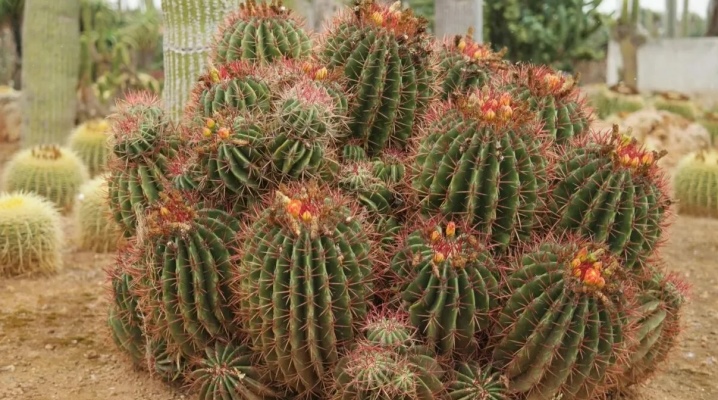
Ferocactus is one of the few varieties of cacti that stand out for their unusual appearance, which can become a real decoration on the windowsill. The culture is easy to care for. However, before you start such a “pet” in your house, you need to think over its location in advance. Because it has long needles, children and pets can be hurt by them.
Botanical description
Ferocactus (ferocactus) is a perennial plant with fleshy and thick shoots of various shapes: oval, spherical, slightly flattened. In its usual habitat, the succulent is capable of reaching impressive sizes. At home, the plant has more modest parameters.
Large ribs of triangular cross-section give massiveness and roughness to the appearance. The skin is firm and smooth, with a variety of green shades. At the edges of the ribs, there is a strip of areola, from which needles grow.
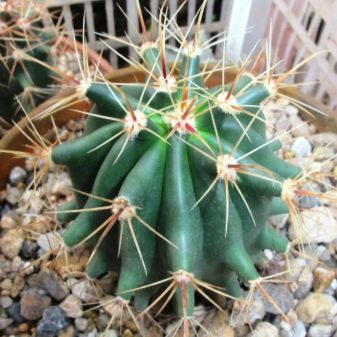
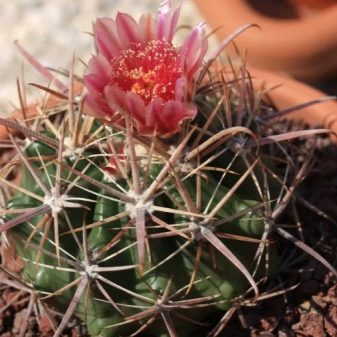
A separate part of the cactus varieties grows with a branched shoot, the other - from only one. The succulent has superficial roots, the maximum depth and width of soil development is not more than 5 cm.A root system of 20 cm or more occurs in those species that grow above 100 cm.
The culture rarely blooms, flowering is characteristic only of adult specimens in the first half of summer. Inflorescences are formed mainly on the crown, less often on the sides. The flowers resemble a bell or an elongated tube, of various colors - from yellow to deep pink. When the flowers fade, oval fleshy fruits are formed in their place, inside which are small black seeds.
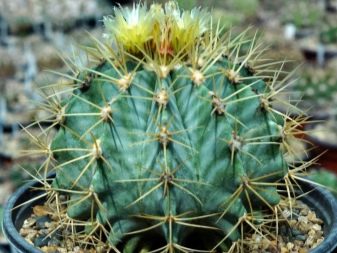
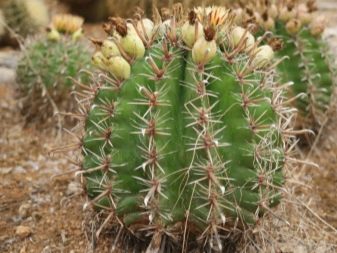
Types and varieties
The culture has more than 30 varieties, differing in shape, height, number of needles, and can form an extensive colony.
Emoryi - one of the few tall cacti, reaching a height of 40-80 cm, and with proper care, all 150 cm. Outwardly resembles an elongated barrel. The young plant has a spherical shape without clearly visible tubercles on the ribs; with growth it becomes cylindrical. Areoles are very pubescent, 5-8 spines grow in a bunch, they are of various colors, from red to pink. The central needle is much longer than the secondary ones. Red or yellow flowers look like a bell. Bright yellow fruit, skin with small scales. The pulp is fleshy, with a small amount of black seeds.
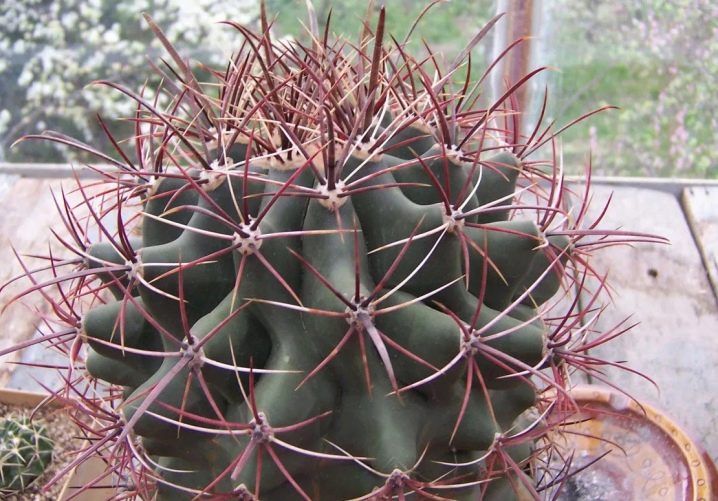
Latispinus (latispinus) or wide-spined - is a small succulent. Height and diameter can reach 40 cm. It looks like a ball or cylinder. The skin is matte and firm, green in color with a blue tint. The plant develops a large number of high ribs - from 15 to 25 pieces, with large areoles. The red spines are quite strong. The central needle in length can reach 8 cm. Excessively long spines tend to twist. Large flowers of a rich pink, red or yellow hue, tubular, up to 5 cm long. Flowering occurs in November-December.
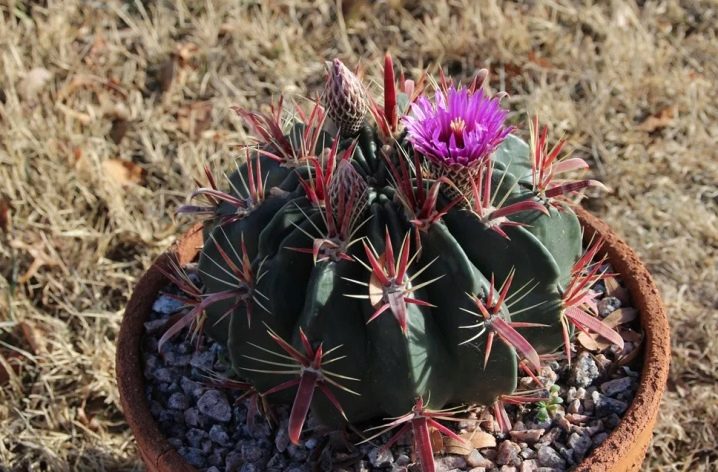
Hairy (stainesii, pilosus) - very beautiful view. The young stem has a neat spherical shape, gradually acquiring a cylindrical one. In a natural environment, the height of the bush can reach 3 m. On the surface there are 15-20 high ribs, with long needles located on them, the tips of which are slightly bent, resembling a hook, red or orange. Funnel-shaped flowers are orange or yellow.

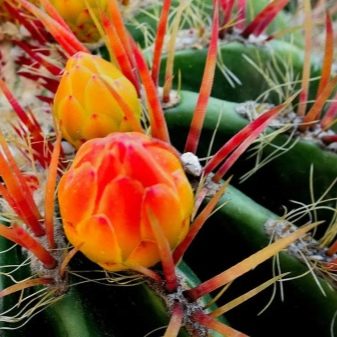
Histrix - is considered one of the most beautiful representatives of ferocactus.The plant is an unbranched, rounded succulent, reaching 110 cm in height and 80 cm in diameter. The surface color is saturated bluish-green, with a large number of ribs (20-40 pieces), on which small fluffy areoles are formed, located at a short distance from each other. As the areoles grow, they can grow together. The spines grow long, 10-15 cm, rather strong, from light brown to red. The flowers are formed on the crown, resembling yellow or red bells.
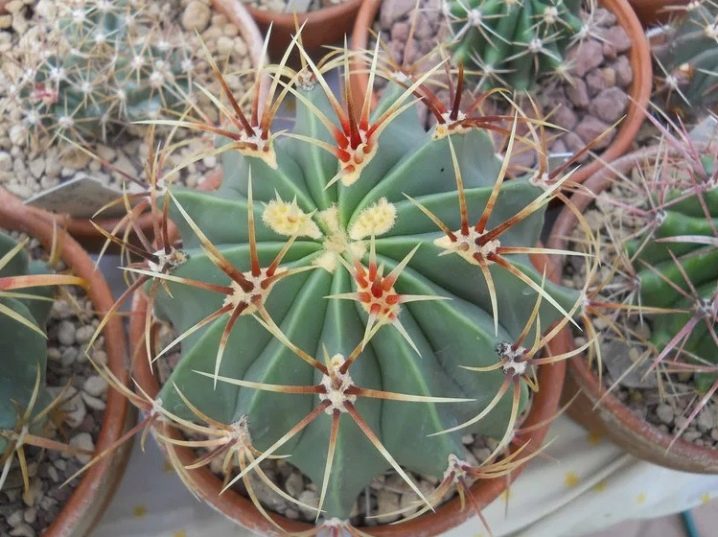
Rectospinus (rectispinus) - the variety is distinguished by the longest needles, capable of reaching a length of 25 cm. The main length of the spines is brown-yellow, the tips are light pink. The cylindrical stem grows up to 100 cm, up to 35 cm in diameter. Tubular flowers are light yellow in color.
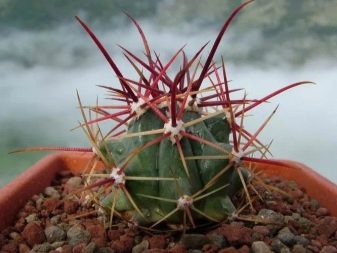
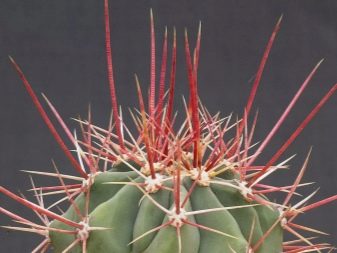
Gracilis - is able to grow up to 150 cm with a trunk diameter of 30 cm. At a young age it has a spherical shape, becoming more cylindrical with growth. The tuberosity is moderate, the number of ribs is 16-24 pieces, on which elliptical or narrow areoles of 1.5 cm are formed. The central spines are striated, red in color, with slightly curved yellow tips, which darken with age. It blooms with red flowers.
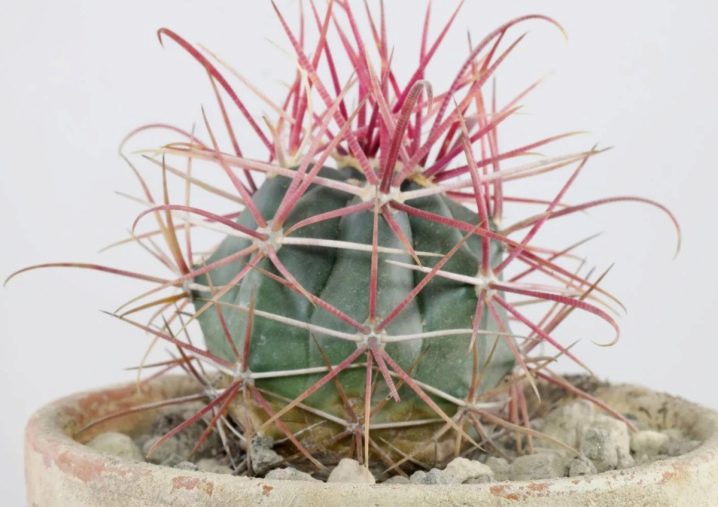
Horridus - the bush looks more like a barrel, as it grows, it changes its shape, making it more bizarre. The main feature of the cactus is the unusual arrangement of the ribs, they are deep and winding, on which a large number of tubercles and areoles are formed. In some cases, there are no areoles on the ribs, and the surface becomes smooth and even. The cactus grows small, a maximum of 20 cm and a diameter of 22 cm. The color of the bush is dark green. The spines are short, strong, almost white, black at the base. It blooms with small yellow flowers at the crown resembling a crown, mainly in summer.
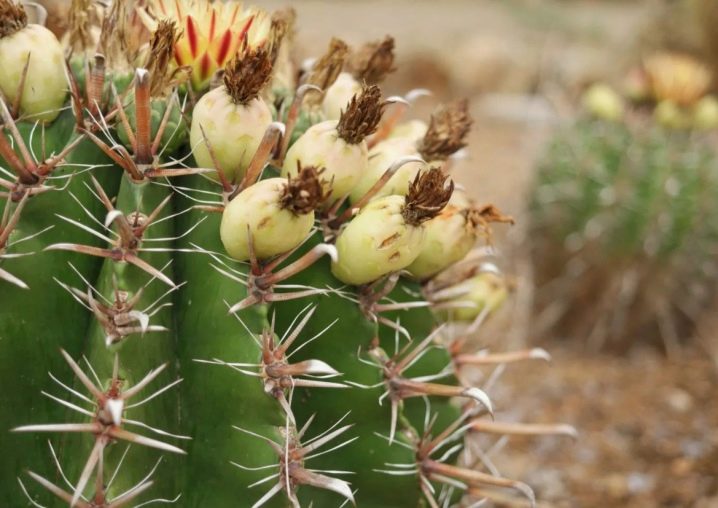
Macrodiscus - a small disc-shaped cactus with a depressed stem. Its height is 10 cm, diameter is 40. The stem is blue-green in color, with a large number of flattened ribs (about 35 pieces). Areolae with slight yellow pubescence. The spines are small, yellow or pink. This variety is easy to grow from seed. The bush will begin to bloom even with a small diameter. The plant blooms with beautiful double flowers of pink or pink-purple color.
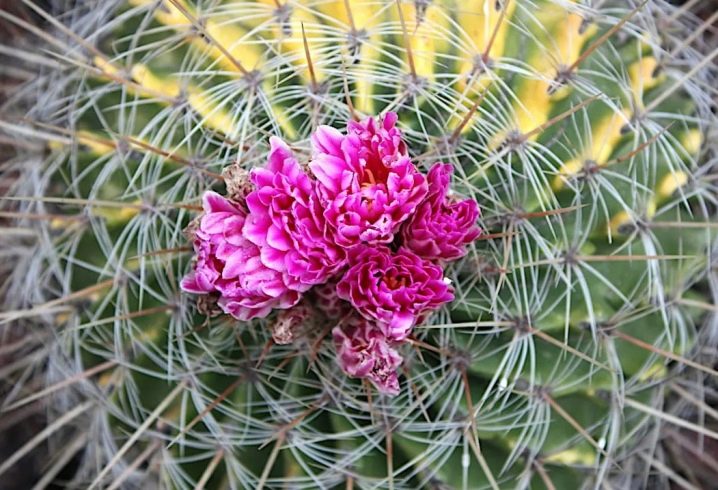
Blue ferocactus (glaucescens) - a large type of spherical cactus, the stem has a velvety epidermis. The skin is bluish in color, with lumpy high ribs, about 13-15 pieces. The needles are slightly spread out and strong, the central one is more powerful. Flowers are yellow with elongated petals.
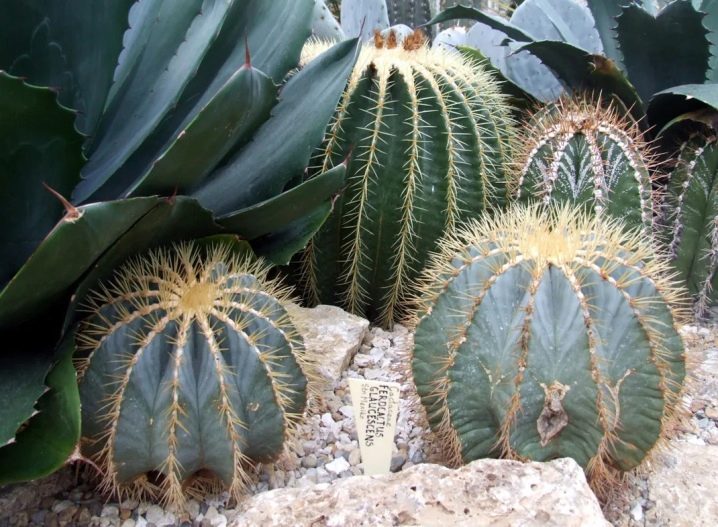
Hamatocactus (hamatacanthus, chrysacanthus) - medium-sized variety, 50-60 cm in height and 30 cm in diameter. On the ribs, pronounced mounds with thin spines are formed. The flowers are large, funnel-shaped, bright yellow in color.
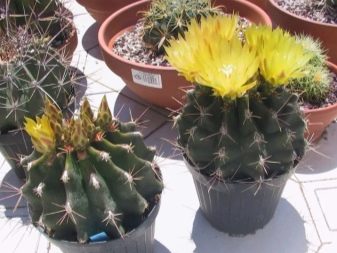

Ford (fordii) - a small cactus, resembling a ball, grows in volume up to a maximum of 40 cm. The ribs are formed about 20. Thorns are thin, white. The color of the stem surface is grayish-green. It blooms with medium-sized flowers of bright pink, purple or yellow-red color.
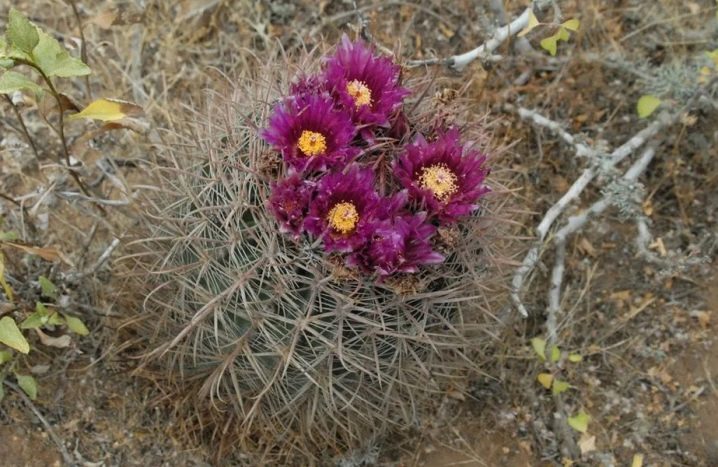
Wislizenii - spherical bush, sometimes cylindrical in shape. Side shoots are not formed. On the surface there are strong and high ribs, about 25 pieces. Areoles are sparsely located. The needles are thin and light. It blooms very rarely, with yellow or red flowers. Small fruits of yellow color.
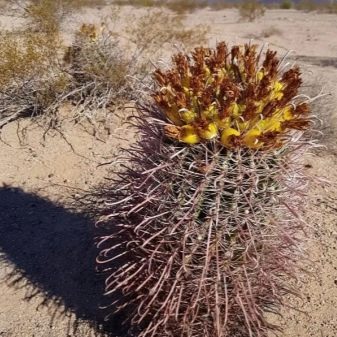
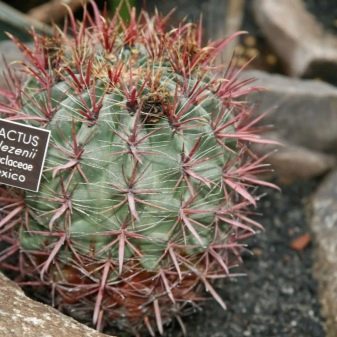
Growing and care
The culture is not capricious and does not require special care skills. It is very easy to grow at home. The succulent plant is resistant to most diseases and is practically not affected by pests. Rarely needs a transplant. The main thing in care is to observe the irrigation regime, apply top dressing and choose the right soil.
Location
Cacti are light-loving plants. For good development, they need a lot of sunlight. With a lack of light, the needles become small, and the appearance becomes pale, painful. In summer, there is a period of active growth, in winter it is at rest. In summer, ferocactus needs high temperatures (+ 30 ... 35 degrees) and fresh air. In winter, the succulent is placed in a cool (+ 10 ... 12) and well-lit room.
It is gradually taught to the bright sun so that burns do not occur on the stem.


The soil
In nature, succulent grows on sandy, poor soils. This feature should be considered when choosing a substrate for ferocactus. The soil mixture can be purchased ready-made, or you can make it yourself. Garden soil, river sand, wood ash and fine gravel are mixed in equal parts. The soil should be well drained and acidic.

Landing
The culture is transplanted once every 3 years, since this is a strong stress for ferocactus. Due to the fact that it has a superficial root system, the adaptation process is complex and lengthy. Difficulty in planting is created by long and sharp spines with a rounded end, freely piercing the skin.
Experienced gardeners, when planting, wrap the cactus with thick paper. For planting, choose pots that are low and wide. A drainage layer is laid at the bottom, it should be ¼ from the pot.
It is necessary to plant it in a new container carefully so as not to damage the roots. To make it easier to remove the plant from the pot, water the soil. The cactus is carefully removed, the remaining soil on the roots is shaken off, placed in a new substrate, tamped and watered quite a bit.
After transplanting the plant, it is quarantined for water for 7-10 days.
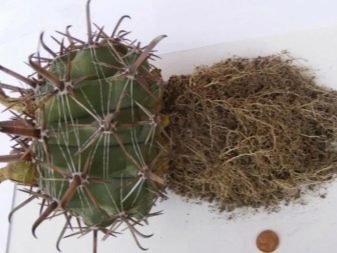
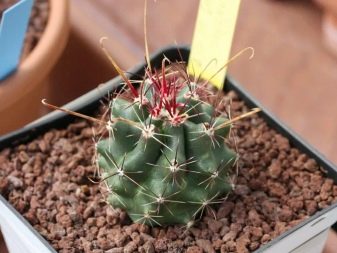
Watering
Irrigation is carried out regularly, but with the condition of complete drying of the earthen coma. When watering, stagnation of water in the pan is not allowed, which must be removed. Excessive moisture can lead to the development of black rot on the roots and even to the death of the plant. And you also need to ensure that during watering, water does not fall on the stem, in order to avoid the formation of burns. In winter, watering is almost completely stopped. In this case, the conditions of detention are taken into account. If the room is warm, irrigation is rare, at a temperature of +10 degrees - a complete failure. Competent wintering guarantees abundant flowering of ferocactus in summer.
It is not necessary to additionally spray the cactus to increase the humidity. Dry air suits him much better.
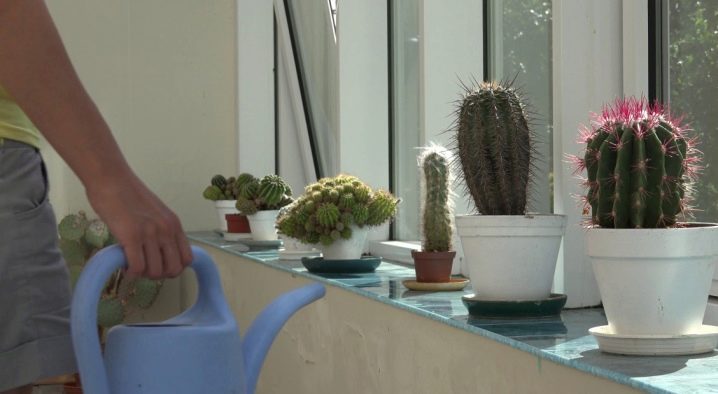
Top dressing
In nature, succulents grow on stony soils, so the bushes are fed once every 2 weeks with special dressings.
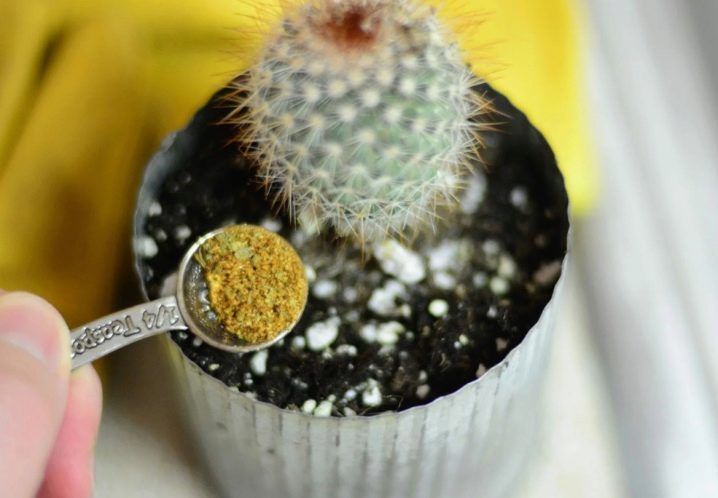
Reproduction
Ferocactus can be propagated in 3 ways: by seeds, babies and cuttings.
They start planting seeds in early spring. Germination is friendly, without much hassle. A wide container is chosen, a drainage layer is laid on the bottom, and covered with a universal soil mixture. The soil is poured with water at room temperature, the seed is spread, and sprinkled a little.
After it is covered with plastic or a jar, put in a well-lit place. The greenhouse begins to be aired in a week. To get healthy and strong shoots, you need to follow the correct irrigation regime. The first month does not allow the soil to completely dry out; it must be constantly wet. The second month - watering is carried out in a pallet. Starting from 3 months, seedlings are irrigated as adults.

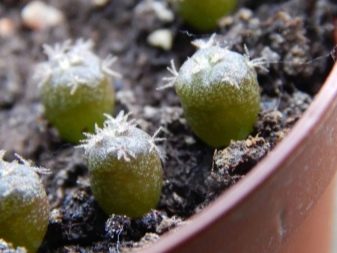
The most convenient and easiest way to reproduce is by children.
However, not all ferocactus species produce lateral shoots. The babies are removed from the maternal stem with sterile tweezers and transplanted into the prepared substrate.
The grafting method is more often used when lateral processes are not formed. With a sharp, sterile knife, part of the trunk is separated and powdered with wood ash. Placed in a warm, well-lit place, but protected from direct sunlight, for 2 days. During this time, the cut will have time to dry out, after which it is planted in the prepared soil. Watering is moderate. After 2-3 weeks, roots appear on the process.
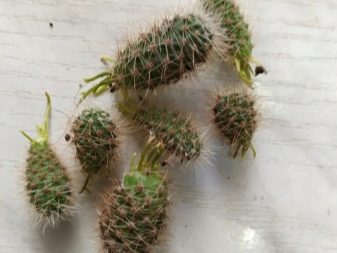
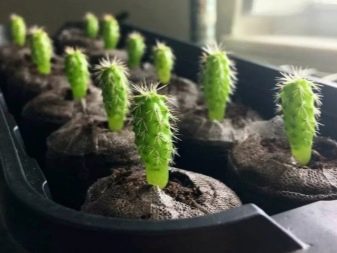























































The comment was sent successfully.